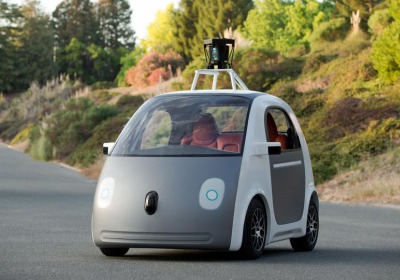Update: Google's robot car is like driving an elevator
Wed, 28 May 2014
Welcome to the future everyone, you may now release all worries, and all control.
Google has released photos and video of its first self-driving vehicle, and a Ferrari 458 it ain't. The car pod people mover has no steering wheel, no gas pedal and no brakes. Two passengers sit inside, one of them presses a button that tells the car where to go and then the vehicle's occupants do... nothing. The car does it all. It's like riding in an elevator.
"Ever since we started the Google self-driving car project, we've been working toward the goal of vehicles that can shoulder the entire burden of driving," Google said in a blog post yesterday. "Just imagine: You can take a trip downtown at lunchtime without a 20-minute buffer to find parking. Seniors can keep their freedom even if they can't keep their car keys. And drunk and distracted driving? History."
Though it wasn't stated explicitly in the videos Google released (see below), one of the people seen in the car appears to be blind, showing another use for such a vehicle..
"There's a big part of my life that's missing and there's a big part of my life that a self-driving vehicle would bring back to me," said the blind man, identified only as "Steve."
The prototype is not made from an existing car converted to autonomous function like the Prius and Lexus hybrids Google has been using in its fleet, but rather a purpose-built two-seater the search engine giant built from the ground up specifically for the project.
"It was a big decision for us to go and start building our vehicles," said Chris Urmson, director of Google self-driving cars. "Really, they're prototype vehicles. They were a chance for us to explore, 'What does it really mean to have a self-driving vehicle?' But in the small amount of time that we've been working on it we have functional prototypes."
The car, which is limited to 25 mph, looks like a rounded-off robot, with none of the crush spaces front and rear that we normally associate with what we typically think of as a "car." That's because, rather than assuming that it'll eventually run into something, the Google car was built assuming its sensors will avoid all contact. Such an assumption frees up a lot of metal and lightens the curb weight significantly. Not to mention allowing all manner of new "drivers" on the road.
"The opportunity for people to just move around and not worry about it, it's going to be incredibly empowering and incredibly powerful for people," said Urmson.
Google plans to build about 100 self-driving vehicles at first, and have them on the road this summer. The first ones will have manual controls and dedicated drivers as backups, but eventually, at some point in the future, the cars will be like the prototype seen here, where the car does all the work. It doesn't sound like Google plans to become a carmaker itself, but more of a technology partner.
"If the technology develops as we hope, we'll work with partners to bring this technology into the world safely," Google said.
Update: Jalopnik says that Roush may be building the Google car in Allen Park, Michigan.
By Mark Vaughn

